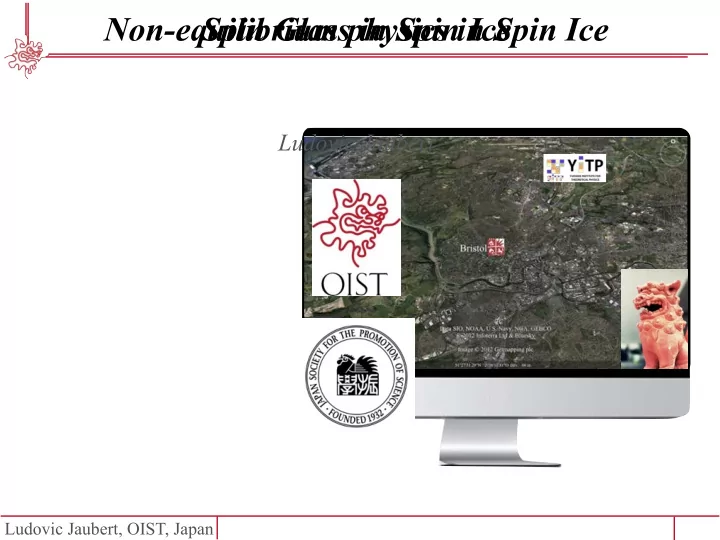

Non-equilibrium physics in Spin Ice Spin Glass in Spin Ice Ludovic Jaubert Ludovic Jaubert, OIST, Japan
Collaborators Masafumi Udagawa Gakushuin University, Japan Roderich Moessner MPI-PkS, Dresden, Germany Claudio Castelnovo Cambridge University, UK paper in preparation Ludovic Jaubert, OIST, Japan
Motivation why non-equilibrium physics ? Model why spin ice ? Results why non-equilibrium physics in spin ice ?
☞ Motivation why non-equilibrium physics ? Model why spin ice ? Results why non-equilibrium physics in spin ice ?
Hall Effect Time-reversal symmetry breaking image taken from https://www.nde-ed.org/
Anomalous Hall Effect Time-reversal symmetry breaking ➥ no magnetic field, but usually ferromagnetism image from http://www.riken.jp/lab-www/cond-mat-theory/onoda/ Nagaosa et al. RMP 2010
Pr 2 Ir 2 O 7 : “Spontaneous” Hall Effect freezing temperature Time-reversal symmetry breaking but no chemical disorder, no long-range order and no finite magnetization Machida et al. Nature 2010
☞ Motivation why non-equilibrium physics ? Model why spin ice ? Results why non-equilibrium physics in spin ice ?
What is spin ice ? pyrochlore lattice Ising spins nearest neighbour Energy monopoles Harris et al PRL 1997 — Gardner et al. RMP 2010 — Rau & Gingras arXiv:1503.04808
See also… Monopole dynamics and Wien effect Artificial Spin Ice in 2D in Dy 2 Ti 2 O 7 , Ho 2 Ti 2 O 7 … nano-lithography Wang et al. Nature 2006 Jaubert et al Nature Phys. 2009 Slobinsky et al PRL 2010 Levis & Cugliandolo PRB 2013 Giblin et al Nature Phys. 2011 Levis et al. PRL 2013 Kaiser et al Nature Mater. 2013 Foini et al. JSM 2013 Mostame et al PNAS 2014 Levis & Cugliandolo EPL 2012
Coupling to itinerant electrons Truncated Ruderman-Kittel-Kasuya-Yosida (RKKY) interactions ➥ next-next-nearest neighbour interactions Can we make it simpler ? Ishizuka & Motome PRB 2013 J 1 = 1 J 2 = J 3 = J Q p = ± 4 Q p = ± 2 Q p = ± 0
Summary of the model Effective model of particles on a lattice constrained by the underlying spins, with chemical potential and contact repulsion/attraction. � Dynamics = single-spin flip = particle hopping (waiting-time Monte Carlo method) Q p = ± 4 Q p = ± 2 Q p = ± 0
☞ Motivation why non-equilibrium physics ? Model why spin ice ? Results why non-equilibrium physics in spin ice ?
Phase diagram at equilibrium Coulomb phase All In - All Out Fragmented spin liquid Jellyfish degeneracy Ω ≈ 1 . 5 N/ 2 degeneracy Ω ≈ 1 . 3 N/ 2 degeneracy Ω = 2
Field quench This is an anisotropic system, so the field direction is important. magnetic field quench at t = 0 time 0
Field quench for spin ice (J = 0) ~ h Castelnovo et al. PRL 2010 — Castelnovo et al. PRB 2011
Field quench for (-1/5 < J < 0) (I) kagome pair annihilation � (II) diluted monopoles => free diffusion (III) no monopoles left => spin freezing � (IV) thermal creation of a pair of monopoles => end of decorrelation J = − 0 . 1 , T = 0 . 1
Field quench for (-1/5 < J < 0) e β (4+8 | J | ) (I) kagome pair annihilation � (II) diluted monopoles => free diffusion (III) no monopoles left => spin freezing � (IV) thermal creation of a pair of monopoles => end of decorrelation J = − 0 . 1 , T = 0 . 1
Field quench for (-1/4 < J < -1/5) (I) kagome pair annihilation is now blocking (II) but diffusion is still free => avalanche � (III) no monopoles left => spin freezing (IV) thermal creation of a pair of monopoles => end of decorrelation J = − 0 . 225 , T = 0 . 01
Field quench for (-1/2 < J < -1/4) Fragmented spin liquid degeneracy Ω ≈ 1 . 3 N/ 2 (I) kagome pair annihilation and diffusion are now blocking � (II) fragmented spin liquid is stabilized over a finite time.
Fragmented Spin Liquid charge order (zinc blende) dimer model diamond lattice Borzi et al. PRL 2013, Brooks et al. PRX 2014, Jaubert Spin 2015
Field quench for 0 < J < 1/5 Same charge monopoles are repulsive => the initial state is strongly out-of-equilibrium J/T = 0 . 125
Field quench for J ≲ 1/4 Qualitative change of behaviour as we approach J = 0.25
Conclusion J1-J2-J3 model (truncated RKKY) nearest-neighbour monopole coupling � • very diverse out-of-equilibrium dynamics • AF Coulomb spin liquid stabilized by [111] magnetic field quench. • attraction between magnetic charges of same sign => new kind of charge frustration • chiral jellyfish structure Ludovic Jaubert, OIST, Japan
Recommend
More recommend